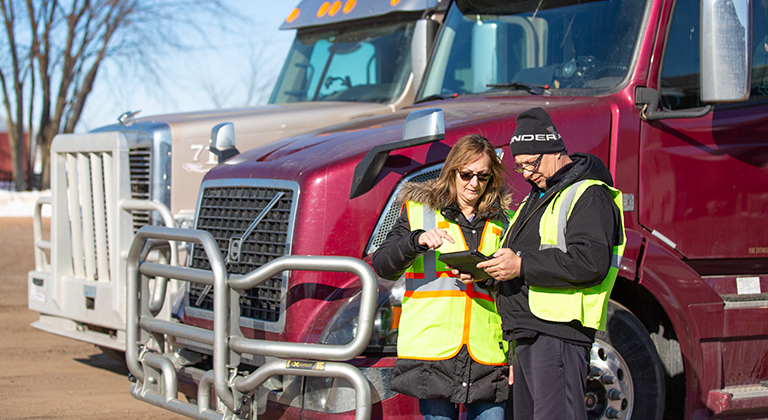Use data to help hire qualified drivers
Take advantage of the resources available to you when seeking safe drivers
By Brad Schneider – Director of Underwriting for Transportation, Sentry Insurance
Your drivers are the biggest exposure for your trucking company. They can make or break your operation. So why take chances when it comes to the hiring process?
You have numerous data-driven resources, federal regulations, and industry associations—like the American Trucking Associations (ATA)—available to help guide you.
Before we review some of these options, let’s focus on one important reason you need good drivers behind the wheel: negligent entrustment.
What’s negligent entrustment and how can you mitigate the risk?
When you assign a driver to deliver your goods or services, it’s your duty to assign someone who’s competent. If your driver demonstrates improper behaviors and causes an incident, your business could be held liable in a negligent entrustment lawsuit.
One of the ways your company could be at risk is assigning duties to someone without exercising proper care, including—but not limited to—conducting background checks.
In a hypothetical example, let’s say you assign a young driver with little experience to deliver cargo. This driver, while traveling over the speed limit, hits another vehicle, injuring its occupants. Not only could your company be held liable for the occupant’s injuries and the vehicle, but you could also be held liable for punitive damages under negligent entrustment laws for not exercising proper care.
The following are some examples of demonstrating proper care involving your drivers.
Start with driver qualifications
Your first measuring stick when considering a prospective driver is whether they meet the requirements of the Federal Motor Carrier Safety Administration (FMCSA).
At minimum, qualified prospective drivers need to:
Be at least 21 years old
Pass a DOT physical
Speak and read English well enough to interact with the public, understand highway traffic signs and signals, respond to official questions, and make legible entries on reports and records
Pass a road test or equivalent
Complete an application for employment
While these baseline qualifications are important—and essential for compliance on your part—we encourage you to consider additional requirements and, occasionally, stricter qualifications for your drivers, such as:
Being at least 24 years old
Having at least three verifiable years of comparable driving experience
Incurring no more than four moving violations and no more than one at-fault accident in the prior three years
Having no DUIs, positive drug tests, or other major violations in the last three years

FMSCA Drug and Alcohol Clearinghouse
This clearinghouse provides you real-time access to important information about commercial driver’s license drug and alcohol program violations. As an employer, you’re required to register and report to this clearinghouse.
However, you can also perform queries with the clearinghouse to help you determine if prospective employees are prohibited from performing safety-sensitive functions due to unresolved drug and alcohol program violations. Depending on the type of query you’d like to conduct, you may need the driver’s consent beforehand.
Understand that records may not be up to date when you review them. Some violations may not appear until months after the violation has occurred.
You can find more information and FAQs on the FMCSA Clearinghouse website. Consult your legal, human resources, and safety professionals regarding appropriate ways to implement clearinghouse requirements in your workplace.
Examine Motor Vehicles Records (MVRs)
As part of your hiring practice, consider—based on your circumstances—reviewing MVRs of all candidates before selecting a driver. Major violations to look for include:
Reckless driving, speed contest (racing), driving 15 mph or more over posted limit
Leaving the scene of a crash (hit and run), evading arrest, misrepresentation to avoid arrest
Homicide, assault, or felony by motor vehicle
Driving while impaired (DUI/DWI) or illegal possession of drugs or alcohol
Refusing an alcohol test
Traffic violation resulting in fatality
Driving while license is suspended, revoked, or has been denied
These violations are red flags when hiring. However, you’ll want to dig a little deeper for other warning signs. Look for behavior patterns that may surface. Did the driver change jobs often? Are there gaps in employment? These can be signs there were performance issues in the past.
Here, too, the data that appears on an MVR may not be up to date when you’re reviewing them. There are services available to alert you when a driver’s MVR changes. Consult your legal, human resources, and safety professionals for the proper way to conduct and use MVR checks and records.
InCheck: An employment screening solution for Sentry customers
InCheck provides comprehensive background and employment screening services. Accredited through the Professional Background Screening Association, InCheck helps deliver a picture of applicants—based on your organization’s requirements—to help you make the best hiring decisions possible.
InCheck also monitors state and national legal and regulatory changes that might affect you and your candidates, and keeps you informed along the way.
Consult with your human resources and legal professionals to make sure InCheck works for your employment setting.
We’re here to help you, too
Sentry trucking customers don’t have to navigate the hiring process alone. Our Safety Services team is available to help you meet your responsibilities under federal rules—including MVR and FMCSA clearinghouse checks.
Our consultants can help you develop a driver qualification file for each employee, conduct safety training, and provide reviews of your safety program.
We work with the ATA to understand the latest regulations and industry trends to educate trucking companies so you can be knowledgeable in the areas of driver hiring and retention and still continue to focus on the job at hand.
Together, we’re working to support the trucking industry and help keep the roads safer for everyone.
This document is made available by Sentry Insurance Company and its subsidiaries and affiliates (collectively “Sentry”) with the understanding that Sentry is not engaged in the practice of law, nor is it rendering legal advice. The information contained in this document is of a general nature, and neither that information nor the hypothetical loss example included in this document is intended to address the circumstances of any particular individual, entity, or set of facts. Legal obligations may vary by state and locality. No one should act on the information contained in this document without legal advice from competent and licensed local professionals. THE INFORMATION CONTAINED IN THIS DOCUMENT IS DISTRIBUTED BY SENTRY “AS-IS,” WITHOUT ANY WARRANTIES. SENTRY WILL HAVE NO LIABILITY TO ANY PERSON OR ENTITY WITH RESPECT TO ANY LOSSES OR DAMAGES CAUSED, OR ALLEGED TO HAVE BEEN CAUSED, DIRECTLY OR INDIRECTLY BY THIS DOCUMENT, REGARDLESS OF WHETHER SUCH CLAIM IS BASED ON CONTRACT, WARRANTY, TORT (INCLUDING NEGLIGENCE AND FOR PROPERTY DAMAGE AND DEATH), OR OTHER GROUNDS.
Advocates for the trucking industry
Sentry Insurance and the American Trucking Associations work in tandem to support growth and resiliency.

About Brad
Brad Schneider is the Director of Underwriting for Transportation for Sentry Insurance. He’s been working in the Transportation industry for 16 years.
Related resources
Trucking-specific guides
Our trucking resources page offers valuable information on insurance coverages, safety resources, and retirement strategies tailored to trucking company owners.
Protect my employees 101 guide
Help attract and retain skilled talent at your business by offering these programs, services, and insurance options.
Other ATA articles
Timely claims reporting helps protect your business
The trucking industry faces mounting challenges from rising insurance costs driven by legal system abuses and varying state negligence laws. Learn how prompt claims reporting can help protect you and your fleet.
Crash management for drivers
This guide outlines essential crash response steps for truck drivers and fleet owners, focusing on driver safety, minimizing downtime, and reducing liability. Knowing what to do if an accident occurs can help you reduce losses and maintain your reputation.
Your role in reducing distracted driving
Cellphone use is a leading cause of distracted driving. As a fleet owner, you can help drivers put their phones down through education, enforcement—and limiting your contact with them on the road.






